
At a Glance:
How Many Watts Does a Fridge Use?
How to Read Your Refrigerator’s Watt Rating
Top Efficient Refrigerators with Low Watt Usage
Tips for Using Less Energy with a Fridge
It’s not a common inquiry among buyers, but knowing the answer can be a deciding factor in how long a refrigerator lasts and how much it will cost you. The question in mind? How many watts does a fridge use?
These days, there are plenty of ways for users to gauge refrigerator watt rating—it’s just a matter of knowing where to look and how to read the info. You can learn about how many watts a fridge uses in this guide, where our experts explain the details in depth and offer recommended refrigerators with low watt ratings and high performances.
Discover the Best Energy Effficient Refrigerator Deals
Load up on groceries with efficient refrigerators that keep you utility bills down—the best selection in the area is here at Fred's Appliance.
Shop Efficient FridgesHow Many Watts Does a Fridge Use?
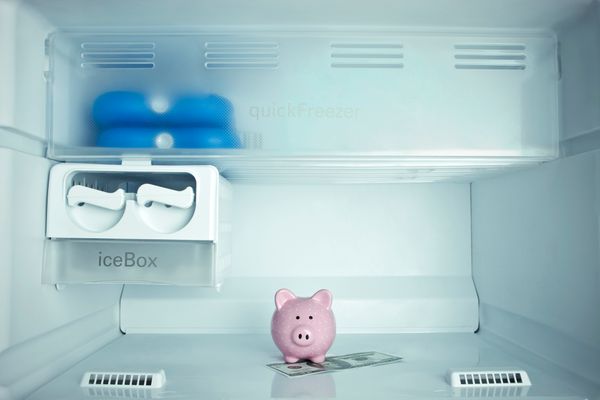
First, it’s important to define what a watt is. Essentially, a watt is a unit that indicates how fast energy is being used. The watt number directly reflects a refrigerator's energy consumption.
Refrigerator wattage that is higher indicates a faster rate of electricity use, which results in more energy use and higher utility bills.
Think of it like measuring car speed. For a car, speed is measured in miles per hour (mph). You can gauge how long it takes to arrive at a certain destination by looking at the speed. But, unlike a car that has a steady speed, your fridge doesn't constantly use electricity at full force. It turns on and off throughout the day to maintain temperature.
On a daily basis, average watt usage of a refrigerator is between 300 and 800 watts. But since fridges cycle on and off, the actual refrigerator energy consumption in watts used may be lower. A good rule of thumb is to divide the refrigerator watt usage by three to estimate daily use. For example, a 500-watt fridge might actually use 167 watts on average each day (500/3).
Based on the estimated refrigerator watt usage per day, you can multiply the daily average by 365 days. In this case, a 500-watt fridge that uses 167 watts daily uses roughly 61,100 watts per year (167 watts/day x 365). Often, watt ratings are indicated in kilowatt-hours (kWh). To determine how many watts a kWh is, simply divide by 1,000.
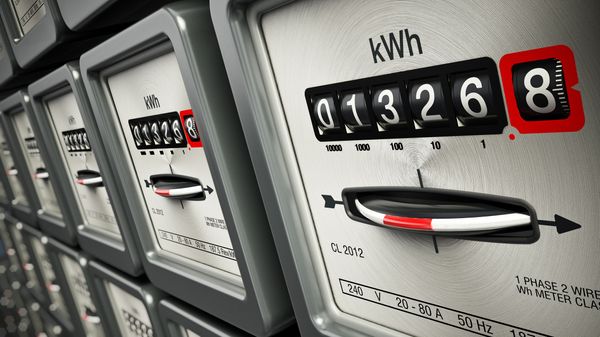
Watt ratings vary between specific models, but here's a rough guideline for what might be considered a good kWh per year rating for different refrigerator sizes according to
ENERGY STAR:
- Small refrigerator (under 10 cubic feet): Approximately 250 kWh per year.
- Medium refrigerator (10-17 cubic feet): Approximately 350 kWh per year.
- Large refrigerator (18-22 cubic feet): Approximately 450 kWh per year.
Did You Know?
Believe it or not, refrigerators don't use as many watts as other appliances. So, what appliances use the most watts? Electric ovens, clothes dryers, and water heaters use more watts than fridges or dishwashers.
How Many Watts Does a Fridge Use by Style?
Due to compressor location, capacity, and efficiency, refrigerator styles perform at different levels of watt usage. Here's the breakdown of each type.
| Fridge Style | Average Watt Usage | Pros & Cons |
|---|---|---|
| How many watts does a top freezer refrigerator use? | 300-500 watts | Top freezer fridges tend to be smaller in size. This means there's less space to cool and potentially lower watt usage. However, the top freezer placement can be slightly less efficient. Warm air naturally rises, so when you open the freezer door, you expose a large chilled section to warm air. This requires more energy to recover the temperature. |
| How many watts does a bottom freezer refrigerator use? | 350-600 watts | The freezer at the bottom can be more efficient because it results in accessing the refrigerator section more. The freezer isn’t exposed too frequently to warm air. However, the freezer size is slightly larger than top freezer refrigerators, potentially causes the fridge to use more energy. |
| How many watts does a side by side refrigerator use? | 500-800 watts | Having two different compartments (fridge and freezer) with independent doors can result in more frequent temperature fluctuations. This increases energy usage to recover temperature. But the convenience of some features (like automatic ice makers or water dispensers) can make up for the watt usage. |
| How many watts does a French door refrigerator use? | 400-700 watts | French Door refrigerators are large, which require more energy to operate. However, many models come with convenient features that make up for the watt usage. Since the fresh food portion is at shoulder level, it’s used more than the freezer, but often, the compressor is located at the bottom, which puts more strain on the appliance. |
How to Read Your Refrigerator’s Watt Rating
More often than not, you don't have to wonder about how many watts does a fridge uses. Many refrigerators will already indicate their energy efficiency ratings. Just look for ENERGY STAR rating for refrigerators, a blue logo placed on all products meeting specific standards for energy efficiency.
Refrigerators with ENERGY STAR certification exceed the minimum standards for efficiency and quality set by the government. This label is usually displayed prominently on the body of any refrigerator because, in most cases, it becomes one of its selling points.
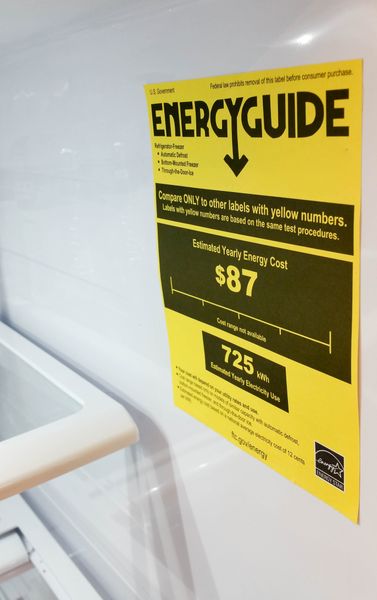
Users should also check EnergyGuide label on a fridge. The US government requires most appliances to show this label, often recognized for its bright yellow and black text. The energy guide refrigerator label provides the average annual energy consumption and operating cost for each model. Here’s how to read the a refrigerator EnergyGuide label.
- Locate the label: Look for a bright yellow sticker with black text titled "Energy Guide." It's usually stuck on the inside, on a shelf, or the door lining. It should display information about the refrigerator's estimated yearly energy consumption and cost.
- Read the information on the refrigerator: The energy guide label refrigerator shows you key features of the refrigerator (and the similar models that make up the cost range). It will also list the manufacturer, size, and model of the refrigerator.
- Find the Kilowatt-hours (kWh) per year: The label shows the kWh per year, representing the estimated annual energy consumption. That's the primary value for assessing energy efficiency.
- Find the yearly energy cost: Next to the kWH indicator, there's usually the estimate of energy cost per year. You can also find the range of operating costs for similar models above these two numbers.
Learn More: 8 Best Refrigerator Brands
Top Efficient Refrigerators with Low Watt Usage
Here are some of the best energy efficient refrigerators that keep watt use low. Check out the following efficient refrigerator reviews and find out which one is the best for your home.
GE® 17.5 Cu. Ft. Stainless Steel Top Freezer Refrigerator
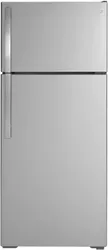
This freestanding GE fridge may be small and compact, but it can fit many items, thanks to the full-width shelves, door bins, and multiple drawers. The temperature control hangs at the front, easy to use to manage your freezer and refrigerator compartments. It's estimated to use 359 kWh annually, which is on the lower end of watt usage.
⭐Featured GE GTE18GSNRSS Review:
"Good product. Great on electricity, saves me money!"
Café™ 22.3 Cu. Ft. Platinum Glass Counter Depth French Door Refrigerator

With an average annual cost of operation of around $84, this Café refrigerator is estimated to use doesn’t make a big impact on your monthly energy bill. It comes with many features that increase efficiency, such as the external water dispenser comes with an autofill function. Four compartments provide better food organization, plus it reduces the amount of cold air that escapes when retrieving items.
⭐Featured Cafe CXE22DM5PS5 Review:
"Great fridge. Excellent storage organization. Love it."
GE Profile™ 22.1 Cu. Ft. Fingerprint Resistant Stainless Steel Counter Depth French Door Refrigerator
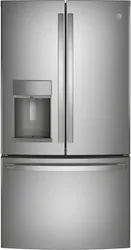
Shop This GE Profile Refrigerator
This GE Profile uses around 665 kWh per year with an estimated cost of $80 annually. It comes with an ENERGY STAR certified performance, plus a sleek counter depth design for the modern details you crave in the kitchen. A multiple-drawer system ensures tidy organization, each with its own temperature control.We also love the drop-down tray that can be hidden when not in use.
⭐Featured GE Profile PYE22KYNFS Review:
"Lots of interior space for a counter depth refrigerator. Ice and water dispenser works great and the water sensing option works great."
Bosch® 800 Series 20.5 Cu. Ft. Stainless Steel Counter Depth French Door Refrigerator
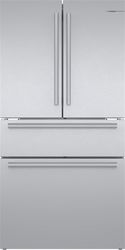
This ENERGY STAR-certified Bosch 800 model is one of the more energy-efficient refrigerators around. It's estimated to use 568 kWh per year with an estimated yearly energy cost of $69. Controlling the temperature is easy with the HomeConnect app, allowing you to manage the unit with the most efficient watt usage. And with all of Bosch's innovative technologies combined in one fridge (from VitaFreshPro to AirFresh Filter), your food stays fresh all the time.
⭐Featured Bosch B36CL80SNS Review:
"I really like the three temperature zones and the fact that one of them can be changed depending on what one needs to store."
Thermador® Masterpiece® 20.8 Cu. Ft. Stainless Steel Counter Depth French Door Refrigerator
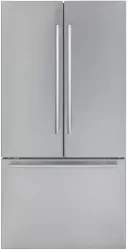
Shop This Thermador Refrigerator
This Thermador Masterpiece French door refrigerator is the epitome of refined sophistication. A select series of premium features include an internal water and ice dispenser that gives the exterior a nice, clean look, plus the ThermaFresh system that's the real star. It allows you to control temperature and humidity to guarantee freshness. Energy-wise, this model sits around the average for its capacity with 570 kWh of usage per year.
Beko 36 in. 20.9 Cu. Ft. Fingerprint Free Stainless Steel French 4-Door Refrigerator

When talking about energy efficiency you can't go wrong with Beko. It's been awarded the ENERGY STAR Partner of the Year Award for three years in a row. With four doors (two for the refrigerator compartment, and two for the double freezer compartments), you'd think this fridge guzzles electricity. But it's very = efficient with about 565 kWh of energy use per year (or about $68 in yearly cost). Efficient, indeed.
⭐Featured Beko BFFD3626SS Review:
“I love everything about this fridge. I love the large ice drawer. We are a family of 4 and never ran out of ice this summer. I love how fresh it keeps food.”
Tips for Using Less Energy with a Fridge
Is there a way to use less energy with your fridge? Absolutely. Look out for the following tips.
- Set the right temperature. Don't over-chill your refrigerator. The ideal fridge temperature is between 35-38 degrees Fahrenheit, while the freezer should be between 0-5 degrees Fahrenheit. Lowering the temperature by 10 degrees can increase energy use by 25%. You should also constantly monitor your fridge to ensure the temperature settings remain accurate always.
- Develop good fridge habits. Good habits when you use your fridge include the following:
- Minimizing door opening.
- Not overcrowding the fridge.
- Cooling food before storing.
- Not using your refrigerator to thaw food.
- Cleaning up spills.
3. Perform maintenance on the fridge regularly. Clean the dirty condenser coils on the back of your fridge; they can reduce efficiency. Also, inspect your door seals to see if there are any cracks or tears. And finally, defrost your freezer and refrigerator from time to time to prevent ice buildup.
The growing number of homeowners dedicated to doing their part in living a more sustainable lifestyle starts with knowledge. Understanding how many watts a fridge uses is one of the simplest ways to join the initiative and help make smarter decisions that have their perks on your monthly utility bill. There’s plenty to learn and a large selection of efficient fridges to explore, and the best place for both is Fred’s Appliance. Visit one of our appliance stores nearby for expert advice on the topic and the area’s largest stock of fridges.
Learn More: 8 Best High Efficiency Washers
Why Trust Fred’s Appliance?
Fred's Appliance is the go-to store for all your appliance needs in the inland Northwest area. Established in 1962, Fred's Appliance has been serving customers for over five decades and counting. With an experienced and knowledgeable staff, Fred's provides a welcoming atmosphere that helps customers find the best product to fit their needs, budget, and lifestyle.
When you shop with Fred's Appliance, you can be sure that you're getting the best brands at the best prices. In our store, you will find a variety of refrigerators, ranges, wall ovens, cooktops, dishwashers, and more. We also carry washers and dryers in both front-load and top-load styles. Not only are we dedicated to providing an unbeatable selection of appliances, but we are equally committed to the local community. We proudly support many charitable organizations throughout Washington, Idaho, and Montana. When you shop at Fred's Appliance, you're not only getting a great product but helping out your neighbors too!
Shop Refrigerators at Fred’s Appliance
If you're looking for a great appliance shopping experience, shop refrigerators online or visit one of our showrooms in Washington, Idaho, or Montana to see what a difference buying locally with an experienced retailer makes. Our appliance experts will be happy to help you with how many watts does a fridge uses. Contact us today and discover the perfect appliance for your home.
Learn More: Energy Star Appliances: Do They Really Save You Money?
